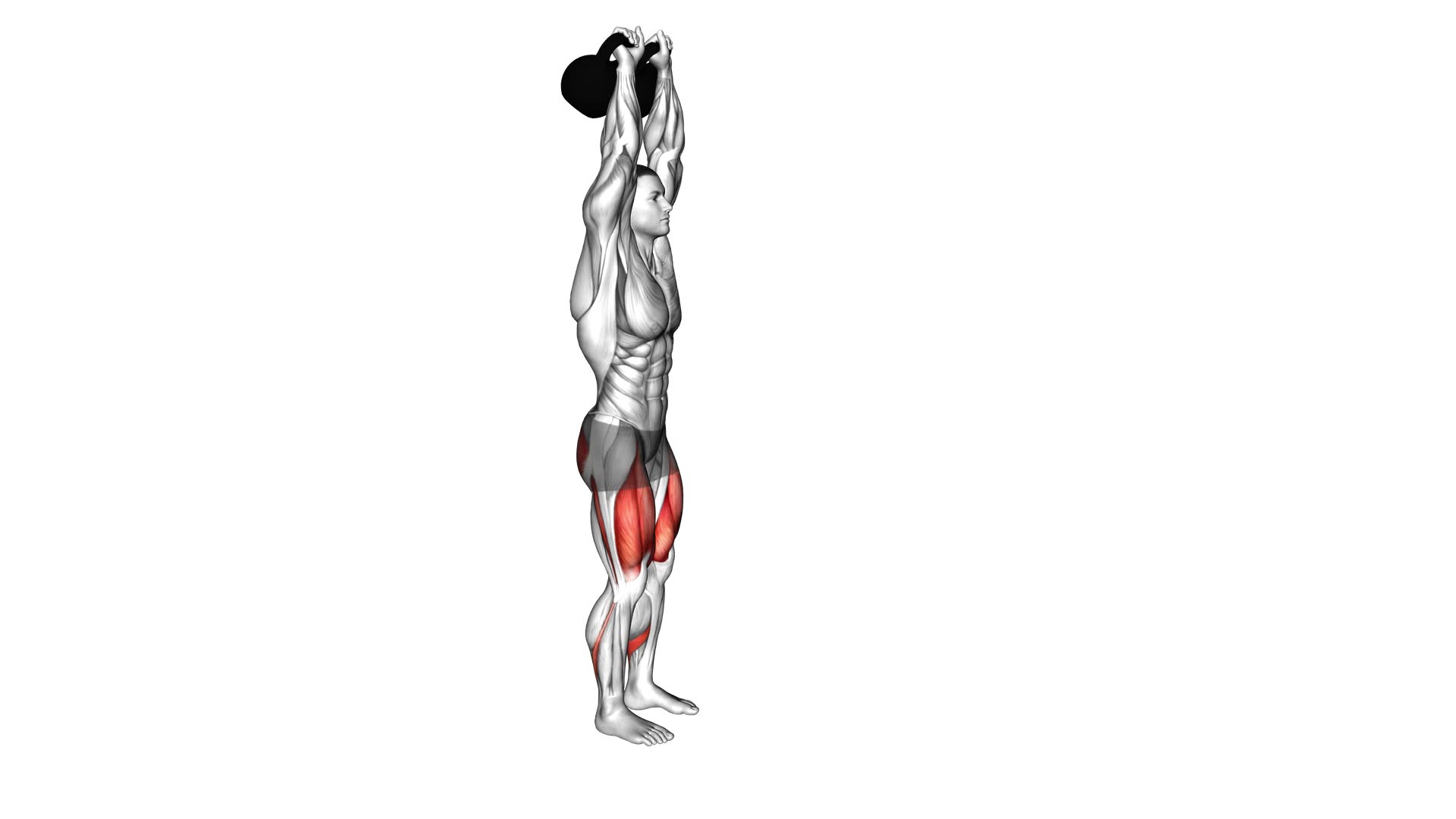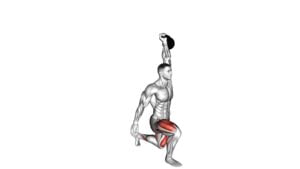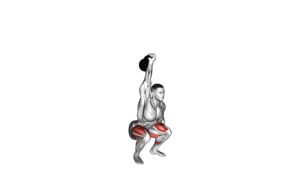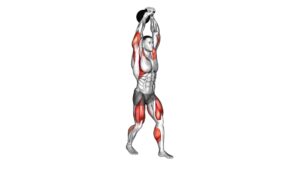Kettlebell Overhead Lunge – Video Exercise Guide & Tips

Are you looking for a challenging exercise that targets multiple muscle groups? Look no further than the kettlebell overhead lunge.
Watch This Exercise Video
This video exercise guide will walk you through the proper form and technique, as well as provide tips to avoid common mistakes.
With variations and modifications available, you can easily incorporate kettlebell overhead lunges into your workout routine.
Get ready to strengthen your legs, core, and upper body with this effective exercise.
Key Takeaways
- Targets multiple muscle groups
- Improves balance and stability
- Increases core strength
- Enhances overall fitness
Benefits of Kettlebell Overhead Lunges
Improve your strength, stability, and mobility with the benefits of Kettlebell Overhead Lunges. This exercise is a powerful way to enhance your overall fitness and achieve a stronger and more stable body. By incorporating kettlebell overhead lunges into your workout routine, you can experience improved balance and increased core strength.
One major benefit of kettlebell overhead lunges is the improvement in balance. As you lunge forward while holding a kettlebell overhead, your body needs to engage multiple muscles to maintain stability. This not only strengthens your legs and glutes but also activates your core muscles to keep you upright and balanced. Over time, this exercise can help you develop better proprioception and stability, which can be beneficial in various activities and sports.
Additionally, kettlebell overhead lunges are highly effective in increasing core strength. The overhead position of the kettlebell forces your core muscles to work harder to stabilize your body during the lunge. This constant engagement of your core muscles helps to strengthen them and improve their overall functionality. A stronger core not only enhances your athletic performance but also contributes to better posture and overall body alignment.
Incorporating kettlebell overhead lunges into your workout routine can provide numerous benefits, including improved balance and increased core strength. By challenging your body in this way, you can enhance your overall fitness and achieve a more stable and mobile body.
Proper Form and Technique
To perform the kettlebell overhead lunge with proper form and technique, maintain a stable and upright position throughout the movement. This is of utmost importance as it ensures that you engage the correct muscles and avoid injury. Proper form and technique have numerous benefits, such as improving balance, stability, and core strength. By keeping your torso upright and your core engaged, you challenge your body to stabilize the weight overhead while also working the lower body muscles.
There are some common errors to watch out for when performing the kettlebell overhead lunge. One mistake is leaning too far forward, which puts excessive strain on the lower back. Another error is allowing the kettlebell to drift out of alignment with your body, causing unnecessary stress on the shoulder joint. To prevent these errors, focus on keeping your chest up and your shoulders back as you lunge.
Modifications and variations can be made to suit your fitness level and goals. If you're new to this exercise, you can start by using a lighter kettlebell or even a dumbbell. As you become more comfortable, you can increase the weight and intensity. You can also try different lunge variations, such as reverse lunges or walking lunges, to target different muscle groups.
To incorporate the kettlebell overhead lunge into your workout routine, start by warming up your muscles with some dynamic stretches or light cardio. Then, perform 2-3 sets of 8-12 reps on each leg, resting for 30-60 seconds between sets. As you progress, you can increase the number of sets or reps. Remember to listen to your body and adjust the weight and intensity accordingly.
Here are some tips and guidelines to ensure proper form and technique during the kettlebell overhead lunge:
- Start with a light kettlebell and gradually increase the weight as you become more comfortable.
- Keep your core engaged and your chest up throughout the movement.
- Step forward with control, ensuring that your knee doesn't extend past your toes.
- Keep the kettlebell directly over your head, aligned with your shoulder and wrist.
- Breathe out as you push through your front heel to return to the starting position.
- Maintain a steady pace and avoid rushing the movement.
Common Mistakes to Avoid
Avoiding common mistakes is crucial when performing the kettlebell overhead lunge to maintain proper form and technique. Here are some common mistakes to avoid and tips for improvement:
- Lack of core stability: Many people tend to neglect engaging their core muscles during the kettlebell overhead lunge. To improve your core stability, focus on keeping your abs tight and your spine aligned throughout the movement. This will help prevent unnecessary strain on your lower back.
- Overextending the arms: One common mistake is fully locking out the arms during the overhead portion of the lunge. Instead, keep a slight bend in your elbows to avoid unnecessary stress on your joints. This will also help you maintain better control of the kettlebell.
- Leaning too far forward: It's important to maintain an upright posture throughout the lunge. Avoid leaning too far forward, as this can put excessive strain on your knees and lower back. Keep your chest lifted and your shoulders back to ensure proper alignment.
- Neglecting proper foot positioning: Pay attention to your foot placement during the kettlebell overhead lunge. Make sure your feet are hip-width apart and pointing forward. Avoid allowing your knees to cave inwards or roll outwards, as this can lead to instability and potential injury.
Variations and Modifications
To add variety and challenge to your kettlebell overhead lunge routine, there are several variations and modifications you can incorporate.
One way to switch things up is by using different equipment. Instead of using a kettlebell, you can try using a dumbbell or a medicine ball to perform the overhead lunge. This can help target different muscles and add a new level of difficulty to your workout.
Another variation you can try is the walking overhead lunge. Instead of staying in one spot, you can take steps forward or backward while performing the exercise. This not only challenges your balance and coordination but also adds a cardiovascular element to the movement.
If you're looking for advanced progressions, you can try adding a twist to the overhead lunge. As you lunge forward, rotate your torso towards the side of your front leg. This engages your obliques and adds an additional core challenge. You can also incorporate a knee drive at the top of the lunge to further engage your hip flexors and core muscles.
Remember to always start with lighter weights and gradually increase the load as you become more comfortable with the variations. Listen to your body and make sure to maintain proper form throughout the exercises.
Tips for Incorporating Kettlebell Overhead Lunges Into Your Workout Routine
When incorporating kettlebell overhead lunges into your workout routine, it's important to follow these tips:
- Start with proper form:
Before adding weight or increasing intensity, make sure you have mastered the basic lunge technique. Focus on keeping your core engaged, chest lifted, and front knee aligned with your ankle.
- Begin with lighter weights:
If you're new to kettlebell overhead lunges, start with a lighter weight to ensure proper form and prevent injury. As you become more comfortable and confident, gradually increase the weight.
- Increase intensity gradually:
To challenge yourself and continue progressing, you can increase the intensity of your kettlebell overhead lunges. This can be done by either increasing the weight of the kettlebell or by adding more repetitions or sets to your workout.
- Explore advanced modifications:
Once you have mastered the basic kettlebell overhead lunge, you can explore advanced modifications to further challenge yourself. This can include adding a pause at the bottom of the lunge, incorporating a balance element by lifting your back leg, or performing the exercise on an unstable surface like a Bosu ball.
Frequently Asked Questions
What Is the Recommended Weight for a Kettlebell When Performing Overhead Lunges?
When performing overhead lunges with a kettlebell, it's important to consider the recommended weight.
The recommended weight for a kettlebell can vary depending on your fitness level and strength. Beginners may want to start with a lighter weight to focus on proper form and technique.
As you progress, you can gradually increase the weight to challenge yourself.
Remember to listen to your body and make modifications as needed to ensure a safe and effective workout.
How Many Sets and Reps Should I Do When Incorporating Kettlebell Overhead Lunges Into My Workout Routine?
When incorporating kettlebell overhead lunges into your workout routine, it's important to consider the recommended sets and reps. This will help you maximize the benefits of this exercise.
By performing multiple sets with a moderate number of reps, you can effectively target your leg muscles and improve stability and core strength.
Adding kettlebell overhead lunges to your routine can enhance overall strength and endurance while promoting better balance and coordination.
Can Beginners Perform Kettlebell Overhead Lunges, or Is It More Suitable for Advanced Fitness Levels?
Beginners can definitely perform kettlebell overhead lunges, as there are modifications available. It's not just for advanced fitness levels. These lunges offer benefits like improved core stability, shoulder strength, and overall lower body strength.
Is It Necessary to Warm up Before Performing Kettlebell Overhead Lunges, and if So, What Are Some Recommended Warm-Up Exercises?
Before performing kettlebell overhead lunges, it's necessary to warm up to prevent injuries and enhance your performance. Stretching before this exercise is important to increase flexibility and reduce the risk of muscle strains.
Incorporating kettlebell overhead lunges into your full body workout routine has several benefits. It engages multiple muscle groups, improves core strength and stability, and enhances overall balance and coordination.
Make sure to warm up properly and reap the benefits of this challenging exercise.
Are There Any Specific Breathing Techniques That Should Be Followed During Kettlebell Overhead Lunges for Optimal Results?
During kettlebell overhead lunges, it's important to focus on your breathing techniques for optimal results. By taking deep breaths in through your nose and exhaling forcefully through your mouth, you can engage your core and stabilize your body. This helps improve your balance and control during the exercise.
Proper breathing also ensures that your muscles receive enough oxygen, reducing fatigue and promoting better performance. So, don't forget to pay attention to your breathing while doing kettlebell overhead lunges for maximum benefits.
Conclusion
Incorporating kettlebell overhead lunges into your workout routine can provide numerous benefits, such as improving strength, stability, and overall lower body function. By maintaining proper form and technique, you can avoid common mistakes and maximize the effectiveness of this exercise.
Additionally, variations and modifications can be implemented to cater to individual fitness levels and goals. So, whether you're a beginner or an experienced athlete, kettlebell overhead lunges are a great addition to any workout routine.

Author
Years ago, the spark of my life’s passion ignited in my mind the moment I stepped into the local gym for the first time. The inaugural bead of perspiration, the initial endeavor, the very first surge of endorphins, and a sense of pride that washed over me post-workout marked the beginning of my deep-seated interest in strength sports, fitness, and sports nutrition. This very curiosity blossomed rapidly into a profound fascination, propelling me to earn a Master’s degree in Physical Education from the Academy of Physical Education in Krakow, followed by a Sports Manager diploma from the Jagiellonian University. My journey of growth led me to gain more specialized qualifications, such as being a certified personal trainer with a focus on sports dietetics, a lifeguard, and an instructor for wellness and corrective gymnastics. Theoretical knowledge paired seamlessly with practical experience, reinforcing my belief that the transformation of individuals under my guidance was also a reflection of my personal growth. This belief holds true even today. Each day, I strive to push the boundaries and explore new realms. These realms gently elevate me to greater heights. The unique combination of passion for my field and the continuous quest for growth fuels my drive to break new ground.







